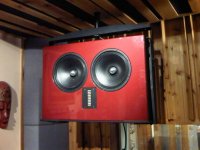I have a pair of Beyma TPL-150H's being unused. I have lots of speakers and amps, but what I need is near-field speakers behind my computer desk for streaming. I hope to circumvent some of the usual requirements by active crossover/DSP/EQ'ing with dbx driverack PA2 (also laying unused), kind of active mini-me version of Spatial Acoustics X series open baffle with one woofer. A decent woofer choice that will take well to EQ'ing the bottom end on a smallish open baffle?.....Or just abandon the idea? Looked over previous posts on Beyma, but no project was quite like this.
If you use the desk as a baffle extension and are really only interested in the best sound at the near-field seat at the desk, you can get respectable bass from something like a 6.5 inch woofer with a sufficiently low resonance. It's not going to play rock concert SPLs or usable 20 Hz, but I ran a pair of dipole speakers in this configuration at work for years and was happy with them at reasonable volume levels.
I have no experience with the DriveRack, so I can't provide an opinion there.
My approach to most speaker projects these days is to prototype as quick and cheap as possible to get a feel for what the basic elements can do. I'd suggest that in this case especially, so you can listen to what the dipole woofer can do and decide if it's enough for you.
I have no experience with the DriveRack, so I can't provide an opinion there.
My approach to most speaker projects these days is to prototype as quick and cheap as possible to get a feel for what the basic elements can do. I'd suggest that in this case especially, so you can listen to what the dipole woofer can do and decide if it's enough for you.
Any example of a suitable 6.5 inch woofer? I don't need a lot of bass, just enough to support the midrange/low-midrange properly.you can get respectable bass from something like a 6.5 inch woofer with a sufficiently low resonance
For midrange dipole applications, I've used and like the Scanspeak 15W/8434G00 and 18W/8434G-00. You need to stay away from their breakup regions, but other than that, they're pretty nice at a reasonable price. I was crossing over around 400 Hz, but that was also at normal 8-10 ft listening distances, so you may be able to get down to the midbass in a near-field desk scenario. Again, part of that is going to come down to how loudly you want them to play and how much EQ you have to apply to get down to the your desired low frequency. There may be other drivers that are more suitable if you want to push the Xmax up, but I don't have a recommendation for anything current along those lines. Someone else may chime in with something though.
Being impatient, I tried plopping on the Beyma TPL-150 (horns not attached) just on top of my main speakers' bass modules. Big round horns with Radian compression drivers sit on top usually. Discrete analogue active crossovers cross them at 1kHz/18dB Butterworth, and so far the sound quality is very good. Seat is not too far, and average loudness at seat runs 75-80dB, so I am not really encountering much known issues, such as Beyer resonance. Adding the TPL horns reportedly makes the top a bit more "forward," so I'm holding off on that since they sound balanced currently. With horn/Radian, I had a gentle EQ to bring down the 1-3 kHz region a bit, but with TPL-150, I don't need that..

That's a very good first step. I often cobble something together with parts/speakers I have on hand to test new drivers or applications for them. I also use an analog active crossover and separate equalizer for a lot of that kind of testing. I still appreciate the ease/instant feedback you get with analog equipment where you just need to twiddle a dial to adjust them.
Attached the Beyma horns and...
Yup, as well documented in the past, a significant bump in frequency response happens at about 7kHz and below. Now a larger percentage of recordings with borderline sound quality in that region sound a bit too forward and highlighted. Some well-recorded, smooth music become more involving and lively. Tried DSP/EQ'ing down this area, and the result is not optimal, as music lost some magic and life, even compared to TPL150 without horns..
I don't understand how so many DIY and commercial speaker designs out there using Beyma TPL150H get around this issue? I may need to detach the horns.
My first question is, are you measuring or just EQing by ear? I could personally never live running the tpl down till 1Khz. Ultimately, we settled on a crossover point much closer to 1.75khz, and that still seemed a compromise. There's increased distortion that's clearly audible that low and a resonance that makes complex music sound harsh and aggressive. The use of the horn will also boost a range lower than 7Khz, so that would need to be addressed as well to get the horn implementation correctly adjusted.
Attachments
- Home
- Loudspeakers
- Planars & Exotics
- "Small" open baffle speaker possible with Beyma TPL-150H?
